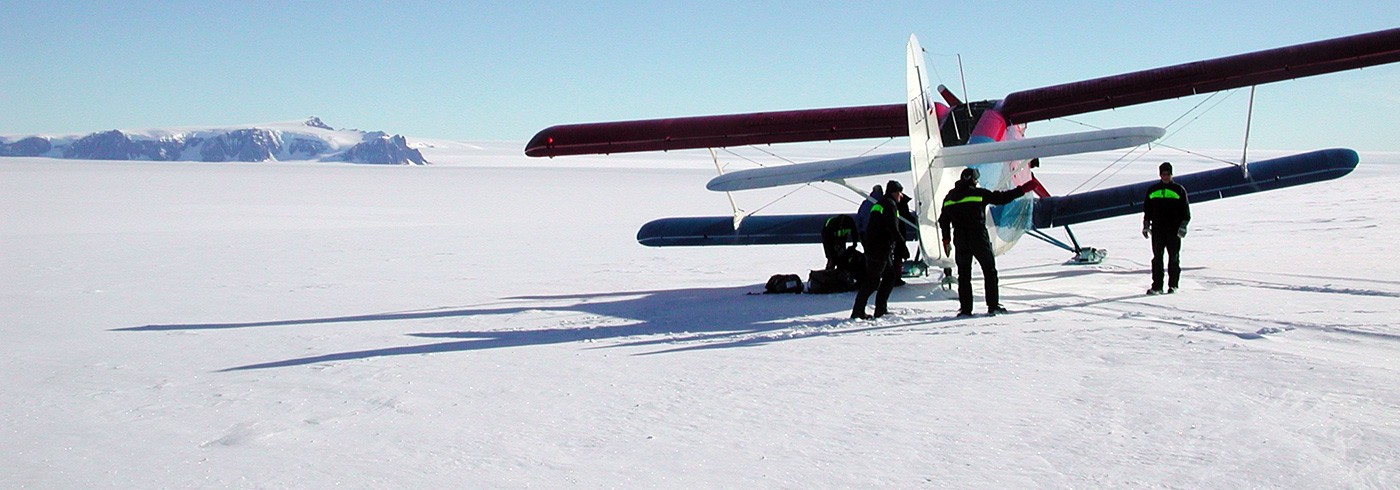High temporal and spatial analysis of snow chemistry in the vicinity of Wasa station, Antarctica
25 January 2004 - 15 February 2004Ice cores from Polar Regions provide information on past climate and the past composition of the atmosphere. The longest ice care record in Antarctica now extends 740 000 years back in time (EPICA community members, 2004). The soluble and insoluble compounds in ice cores have their origin as aerosols (liquid or solid compounds kept in suspension in the atmosphere) and are incorporated in the snow matrix by either wet deposition (with precipitation) or dry deposition (gravitational fall-out). The signals of insoluble and soluble chemical species recorded in ice cores are not directly transferable to the atmospheric aerosol concentration at the site at the time of deposition. In order to interpret the ice core signals as atmospheric concentrations the air to snow transfer processes must be understood, as well as any post depositional process altering the chemical composition of the snow.
This project examines the chemical signal in the surface and near-surface snow, with special focus on the sulfur compounds (sulfate and MSA- methane-sulfonate) on a small temporal and spatial scale. The aim is to investigate the interplay between the chemical species, and examine how representative a single spot sample is. The aim is also to investigate how sublimation influences the chemical signal, a factor that has been poorly treated and mostly only considered as enriching the remaining snow, not taking in to account any changes due to chemical reactions.
The MSA signal in ice cores from Antarctica has shown the opposite response to climatic changes as does the signal in ice cores from Greenland (Hansson and Saltzman, 1993; Legrand et al., 1998) with no satisfactory explanation hitherto. The results from this project will be compared with results from a similar sampling campaign on the Greenland ice sheet on a site with comparable accumulation rates. The idea is that a detailed examination may reveal certain differences in the chemical processes during or after deposition.
Fieldwork
During the second part of SWEDARP 2003/04 fieldwork was carried out from late January to mid February 2004 with the Wasa research station as logistic base. Transportation from Cape Town was carried out via Novolazarevskaya air base in an Ilyushin 76 ML aircraft and the remaining distance to Wasa was operated by small Antonov 2 aircrafts equipped with skiers.
Sampling of snow was conducted in three different manners
- Detailed vertical high resolution snow pit profiles.
- High resolution surface profiles.
- Drilling of 4 m shallow snow cores with a PICO-auger.
The snow pit and surface sampling were conducted close to the Camp Maudheimvidda (CM) drill site of the SWEDARP 1997/98 drill campaign, when a 100m shallow core was obtained (Holmlund et al., 2000). The interpretation of the CM-core chemistry signal will improve with the temporally and spatially detailed investigation of this project. Moreover, an AWS (Automatic Weather Station) is positioned close to the former drill-site and provides valuable meteorological data for the time period of deposition of the sampled snow. Energy balance calculations from data provided by this station have shown that sublimation is significant in the area (van den Broeke, submitted). The 4 m snow cores were drilled on three sites between Wasa station and the nunatak Plogen. In addition a few samples of freshly fallen snow (within minutes prior to the sampling) were collected together with samples from the older snow surface below.
The concentrations of soluble and insoluble compounds in the snow are very low, which demands that every action to diminish the risk for contamination must be taken. Therefore the sampler used clean room suit and vinyl gloves and all tools were thoroughly cleaned prior to use. All samples were collected in Coulter Counter® Accuvettes, which have proven to be satisfactorily clean. Samples were shipped back to Stockholm in a frozen state and stored in a freezer at the Department of Physical Geography and Quaternary Geology, Stockholm University.
Analysis
The snow samples have been analysed for the concentrations of major cations (Na+, K+, NH4+, Mg2+, Ca2+) and anions (F–, Cl–, NO3–·, SO42-) and MSA, using ion chromatography. At the time of writing analysis of the oxygen and hydrogen isotopic ratio is still being conducted.
Outlook
The planned sampling could be completed successfully during the field campaign. Analysis of the surface samples will continue hut the preliminary data from the ion analysis indicate significant differences in the relation between sulfate and MSA compared to the corresponding data from Greenland. When finalising the analysis a sub-annual timescale for the snow pit profiles will be obtained and the chemical signal can be interpreted together with the meteorological data.

